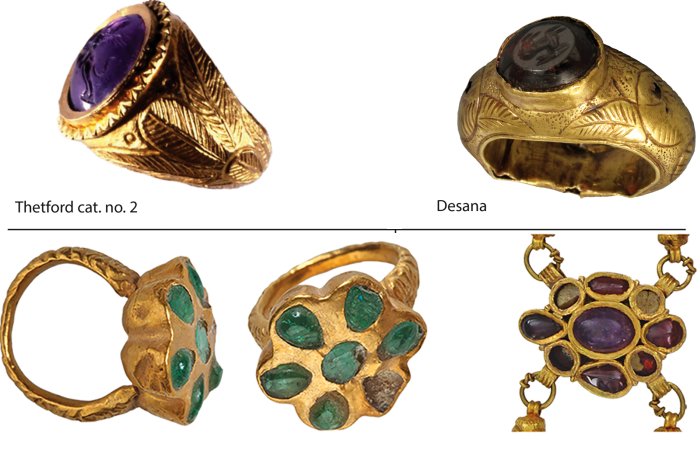Conny Waters – AncientPages.com – Jewellery discovered in a Roman treasure hoard in Thetford Forest, East Anglia, provides evidence that Thetford remained pagan until the 5th century.

Thetford cat. nos. 2, 3 and 4, left, (© The Trustees of the British Museum [used online under a CC BY-NC-SA 4.0 license]) compared with finger-rings from Desana (Turin, Palazzo Madama – Museo Civico d’Arte Antica. By courtesy of Fondazione Torino Musei) and Cortrat, right (photo and copyright © Musée d’Art et d’Archéologie de Châtillon-Coligny).
This finding extends the previously held timeline for when the area was thought to have converted from paganism.
The Thetford treasure was first found by a metal detectorist trespassing on a construction site at Fison’s Way on Gallows Hill, Thetford, in 1979. It consisted of 81 objects, including 22 gold finger rings, other gold jewellery, and 36 silver spoons or strainers.
It is now in the collections of the British Museum and can be seen on display there.
Professor Ellen Swift from the University of Kent presents a well-researched argument suggesting that there is substantial evidence indicating the treasure was buried in the 5th century, as opposed to the previously believed late 4th century.

Multi-gem jewelry from Ephesus, left (Pülz Reference Pülz2020, color pl. 26, cat. no. S184, https://creativecommons.org/licenses/by/4.0/deed.en), and Hoxne, right (© The Trustees of the British Museum – CC BY-NC-SA 4.0
Swift says that evidence at the site confirms the religious context suggested by inscriptions on the spoons in the hoard. This re-dating of the Thetford hoard indicates a pagan cult center survived into the 5th century.
“The site’s economic assets, indicated by the value and variety of the hoard, also show that it may have wielded significant power and authority locally.”
This new chronology is supported by detailed comparisons of spoons and jewelry with context-dated finds from Europe, and with 5th-century objects from the Hoxne hoard in the British Museum, which was discovered after the Thetford hoard and contains many similar items.
The paper reveals that Britain was less isolated, as the treasure items originated from across the Roman empire.
The Thetford jewelry collection showcases a diverse range of styles, indicating that the pieces likely have origins in various locations. Notably, some of the more recently dated finger rings in the hoard are believed to have originated from northern Italy or nearby regions. Additionally, the necklace featuring conical beads is thought to come from the Balkans area of Europe.
Most of the jewellery is generically ‘Mediterranean Roman’ in style, illustrating a geographically widespread shared culture among elites. during the height of the Roman Empire.
This style features intricate designs that often incorporate motifs such as laurel wreaths, mythological figures, and geometric patterns.
These elements reflect both Roman cultural influences and localized adaptations across various regions bordering the Mediterranean Sea.
Source – via Eurekalert
Paper
Written by Conny Waters – AncientPages.com Staff Writer






